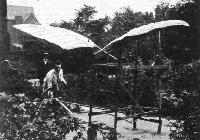M.Goodall, A.Tagg British Aircraft before the Great War (Schiffer)
Deleted by request of (c)Schiffer Publishing
PASSAT monoplane Seagull
Although lacking confirmation, it seems likely that Passat converted the ornithopter into a monoplane with variable incidence wings, as illustrated in Flight 3 February 1912 (p.109). Reportedly fitted with a 15hp Anzani engine, it suffered from engine problems, but may have been the machine with which flights of 100-150 yards were achieved on Wimbledon Common in 1912.
Passat became a naturalized Englishman and, much later, made further attempts with flapping wings at Surbiton, on a machine he termed a 'Helithopter.'
Журнал Flight
Flight, January 27, 1916.
A Direct-Lift Aeroplane
MANY of our readers will doubtless remember the experiments with an ornithopter, or flapping-wing, machine, which were made by M. Passat in 1910, and they will be interested to hear that, not having obtained the results anticipated, chiefly owing to mechanical difficulties in obtaining the wing movements, he has been working for some time on entirely different lines. With his latest machine, which may be described as being of the orthopter type # having revolving wings # he has obtained results which are distinctly encouraging. It is of course impossible to give full details of the invention, but it may be said that, instead of air-screws and planes as usually fitted, M. Passat employs a series of revolving wings, arranged in pairs and moving in opposite directions, so that the blades descend on the outward half of their path. By means of an ingenious cam arrangement each blade on its down stroke presents its full surface to the air, thus producing a lifting effect, while on the upstroke it is turned edgeways, i.e., "feathers," so that it offers a minimum resistance during its upward passage through the air. With the object of demonstrating his theories, M. Passat has built a model, which he will gladly show to anyone who is interested if they will communicate with hm at 106, Durham Road, Wimbledon.
Flight, August 17, 1916.
AIRISMS FROM THE FOUR WINDS,
THERE appears to be something in the Passat wing-flapping machine, and since its original debut it has passed quite beyond the wild freak machine stage. Only shows what solid conviction and consistent perseverance will do. It is only at present a decent sized crude model, but the lift is there, the power of forward motion appears to be, whilst after a short demonstration controllability and the ability to glide seem not impossible.
Flight, September 14, 1916.
Mons. Passat has for a number of years been experimenting quietly with wing-flapping machines, and has now succeeded in getting some quite promising results. In our photograph he is seen at the handle of his latest hand-operated model. Crude as it is, Mons. Passat demonstrated to us recently that he can lift with this model a weight of 80 lbs. This weight, it is true, is only lifted momentarily and not sustained for any prolonged period, but in view of the primitive arrangement even this is not bad for efficiency. Assuming that a man can develop for a short period one-fifth of a horsepower, this would give a lift, if driven by a petrol engine, of 400 lbs. per h.p., which is a somewhat startling figure. It would appear that the research authorities might not be ill-advised in granting Mons. Passat's method of imitating the flight of a bird a trial under more favourable conditions and with a mechanically improved model.




